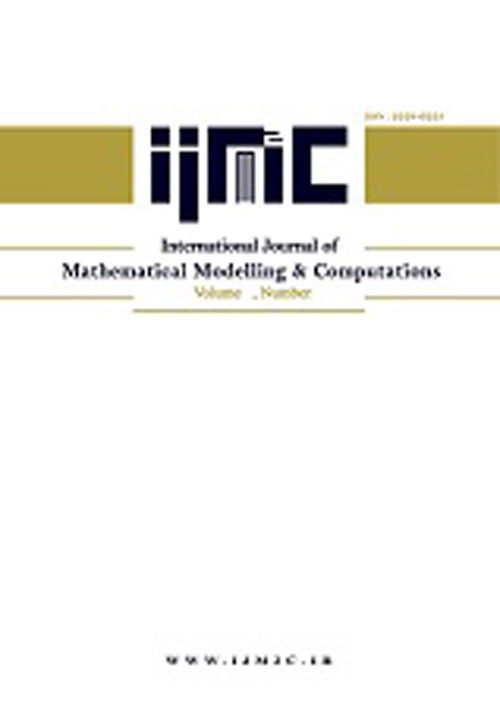فهرست مطالب

مجله بین المللی محاسبات و مدل سازی ریاضی
سال دهم شماره 3 (Summer 2020)
- تاریخ انتشار: 1399/11/25
- تعداد عناوین: 6
-
-
Pages 161-177In this work, a researcher develop $SHEIQRD$ (Susceptible-Stay at home-Exposed-Infected-Quarantine-Recovery-Death) coronavirus pandemic spread model. The disease-free and endemic equilibrium points are calculated and analyzed. The basic reproductive number $R_0$ is derived and its sensitivity analysis is done. COVID-19 pandemic spread is die out when $R_0leq 1$ and its persist in the community whenever $R_0>1$. More than $10%$ of lockdown or home quarantine, above $50%$ and $30%$ identification and isolation of expose and infected individuals respectively, and reduction home quarantine return rate(less than $10%$) can be mitigates the pandemics. Finally, theoretical analysis and numerical results are consistent.Keywords: Coronavirus disease, Lockdown, isolation, Theoretical Analysis, numerical simulation
-
Pages 179-202In this paper, we utilize an algorithm for solving nonlinear ordinary differential equations of Lane-Emden type on a semi-infinite interval. The algorithm is based on an iterative technique and thereproducing kernel Hibert method. We give the convergence analysis for the proposed method. The validity and applicability of the proposed method are demonstrated by some numerical examples. The obtained results and comparison with other methods provide confirmation for the validity of our numerical method.Keywords: Reproducing kernel Hilbert space method, Lane-Emden equation, astrophysics equation
-
Pages 203-225In this study, we first introduce the co-ordinated hyperbolic ρ-convex functions. Then we establish some Hermite-Hadamard type inequalities for co-ordinated hyperbolic ρ-convex functions. The inequalities obtained in this study provide generalizations of some results given in earlier works.Keywords: Convex function, hyperbolic ρ-convex functions, Hermite-Hadamard inequality, integral inequality
-
Pages 227-238
In this paper, the authors establish inequalities of the Hermite-Hadamard-Mercer type for convex functions by applying k-fractional integrals. We prove some new fractional inequalities connected to the left part of Hermite-Hadamard-Mercer type inequalities for differentiable mappings whose first derivatives in absolute value are convex.
Keywords: Convex functions, Hermite-Hadamard inequalities, Jensen-Mercer inequality, k-Riemann-Liouville fractional integrals -
Pages 239-248
The Coronavirus disease 2019 (COVID-19) is a novel pandemic disease that spreads very fast and causes severe respiratory problem to its carrier and thereby results to death in some cases. In this research, we studied the trend, model Nigeria daily COVID-19 cases and forecast for the future occurrences in the country at large. We adopt the Box and Jenkins approach. The time plot showed that the cases of COVID-19 rises rapidly in recent time. KPSS test confirms the non-stationarity of the process (p < 0.05) before differencing. The test also confirmed the stationarity of the process (p > 0.05) after differencing. Various ARIMA (p,d,q) were examined with their respective AICs and Log-likelihood. ARIMA (1, 2, 1) was selected as the best model due to its least AIC (559.74) and highest log likelihood (-276.87). Both Shapiro-Wilk test and Box test performed confirm the fitness of the model (p > 0.05) for the series. Forecast for 30 days was then made for COVID-19 cases in Nigeria. Conclusively, the model obtained in this research can be used to model, monitor and forecast the daily occurrence of COVID-19 cases in Nigeria.
Keywords: COVID-19, model, Forecast, AIC, Log –likelihood -
Pages 249-263
In this paper, a deterministic mathematical model is formulated to study the dynamics of human population subjected to HIV/AIDSwith Herbal medicine and ART as treatments. The total population is divided into eight compartments. The existence, uniqueness, positivity, and boundedness of the solutions are shown. Both treatments have a positive impact on the reduction of viral load in the body. The stability analysis of equilibrium points are are done. Disease free equilibrium point is locally asymptotically stable if the reproduction number is less than unity and unstable for greater than unity.
Keywords: HIV, Herbal medicine, Art, Reproduction Number, Stability

